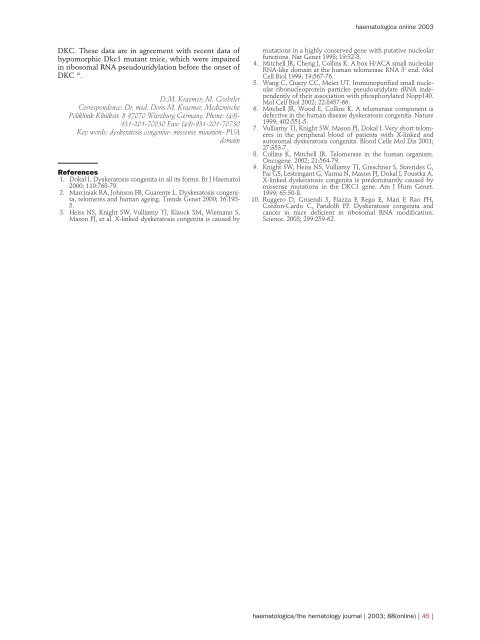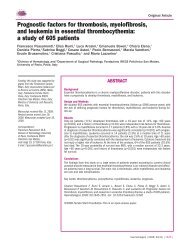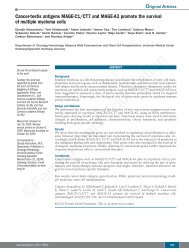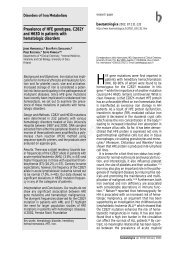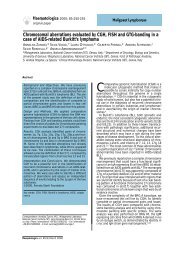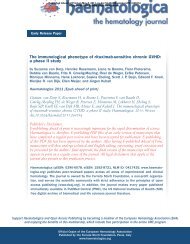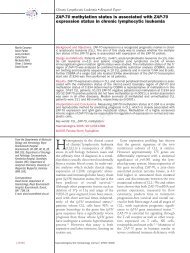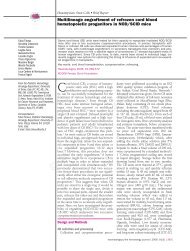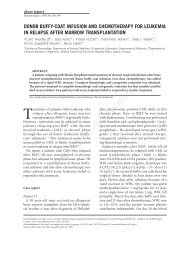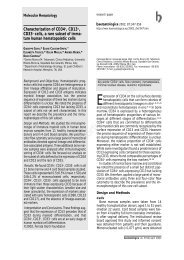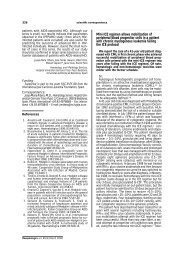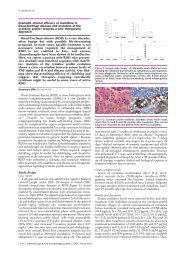Missense mutation in a patient with X-linked dyskeratosis congenita
Missense mutation in a patient with X-linked dyskeratosis congenita
Missense mutation in a patient with X-linked dyskeratosis congenita
You also want an ePaper? Increase the reach of your titles
YUMPU automatically turns print PDFs into web optimized ePapers that Google loves.
DKC. These data are <strong>in</strong> agreement <strong>with</strong> recent data of<br />
hypomorphic Dkc1 mutant mice, which were impaired<br />
<strong>in</strong> ribosomal RNA pseudouridylation before the onset of<br />
DKC 10 .<br />
D.M. Kraemer; M. Goebeler<br />
Correspondence: Dr. med. Doris M. Kraemer, Mediz<strong>in</strong>ische<br />
Polikl<strong>in</strong>ik Kl<strong>in</strong>ikstr. 8 97070 Würzburg Germany. Phone: (49)-<br />
931-201-70030 Fax: (49)-931-201-70730<br />
Key words: <strong>dyskeratosis</strong> <strong>congenita</strong>- missense <strong>mutation</strong>- PUA<br />
doma<strong>in</strong><br />
References<br />
1. Dokal I. Dyskeratosis <strong>congenita</strong> <strong>in</strong> all its forms. Br J Haematol<br />
2000; 110:768-79.<br />
2. Marc<strong>in</strong>iak RA, Johnson FB, Guarente L. Dyskeratosis <strong>congenita</strong>,<br />
telomeres and human age<strong>in</strong>g. Trends Genet 2000; 16:193-<br />
5.<br />
3. Heiss NS, Knight SW, Vulliamy TJ, Klauck SM, Wiemann S,<br />
Mason PJ, et al. X-l<strong>in</strong>ked <strong>dyskeratosis</strong> <strong>congenita</strong> is caused by<br />
haematologica onl<strong>in</strong>e 2003<br />
<strong>mutation</strong>s <strong>in</strong> a highly conserved gene <strong>with</strong> putative nucleolar<br />
functions. Nat Genet 1998; 19:32-8.<br />
4. Mitchell JR, Cheng J, Coll<strong>in</strong>s K. A box H/ACA small nucleolar<br />
RNA-like doma<strong>in</strong> at the human telomerase RNA 3' end. Mol<br />
Cell Biol 1999; 19:567-76.<br />
5. Wang C, Query CC, Meier UT. Immunopurified small nucleolar<br />
ribonucleoprote<strong>in</strong> particles pseudouridylate rRNA <strong>in</strong>dependently<br />
of their association <strong>with</strong> phosphorylated Nopp140.<br />
Mol Cell Biol 2002; 22:8457-66.<br />
6. Mitchell JR, Wood E, Coll<strong>in</strong>s K. A telomerase component is<br />
defective <strong>in</strong> the human disease <strong>dyskeratosis</strong> <strong>congenita</strong>. Nature<br />
1999; 402:551-5.<br />
7. Vulliamy TJ, Knight SW, Mason PJ, Dokal I. Very short telomeres<br />
<strong>in</strong> the peripheral blood of <strong>patient</strong>s <strong>with</strong> X-l<strong>in</strong>ked and<br />
autosomal <strong>dyskeratosis</strong> <strong>congenita</strong>. Blood Cells Mol Dis 2001;<br />
27:353-7.<br />
8. Coll<strong>in</strong>s K, Mitchell JR. Telomerase <strong>in</strong> the human organism.<br />
Oncogene. 2002; 21:564-79.<br />
9. Knight SW, Heiss NS, Vulliamy TJ, Greschner S, Stavrides G,<br />
Pai GS, Lestr<strong>in</strong>gant G, Varma N, Mason PJ, Dokal I, Poustka A.<br />
X-l<strong>in</strong>ked <strong>dyskeratosis</strong> <strong>congenita</strong> is predom<strong>in</strong>antly caused by<br />
missense <strong>mutation</strong>s <strong>in</strong> the DKC1 gene. Am J Hum Genet.<br />
1999; 65:50-8.<br />
10. Ruggero D, Grisendi S, Piazza F, Rego E, Mari F, Rao PH,<br />
Cordon-Cardo C, Pandolfi PP. Dyskeratosis <strong>congenita</strong> and<br />
cancer <strong>in</strong> mice deficient <strong>in</strong> ribosomal RNA modification.<br />
Science. 2003; 299:259-62.<br />
haematologica/the hematology journal | 2003; 88(onl<strong>in</strong>e) | 45 |


